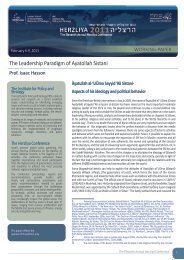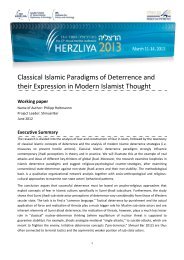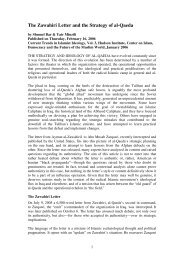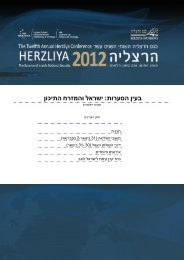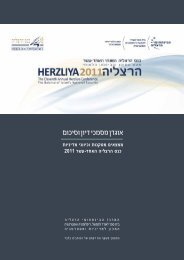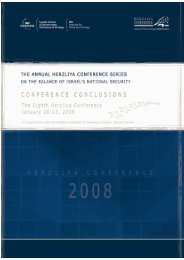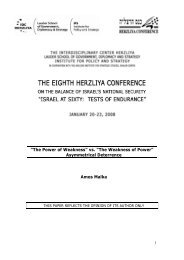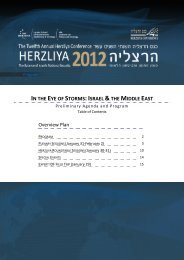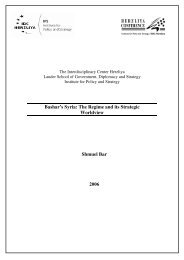<strong>Iran</strong>: <strong>Cultural</strong> <strong>Values</strong>, <strong>Self</strong>-<strong>images</strong> <strong>and</strong> Negotiating <strong>Behavior</strong>irreversible impasse with the reformists, <strong>and</strong> they seem to be wary of taking actionsthat may close the door to future compromise.Obstinacy (sar-sakhtii or khod-sari, literally hard-headedness or own headedness,loner or non-consulter) is perceived in <strong>Iran</strong>ian political culture as a negative trait,insofar as it signifies irrational or non-pragmatic refusal to adapt to changingcircumstances or input of information. Such obstinacy or uncompromising behavior isalso a result of lack of forethought, <strong>and</strong> might even be regarded as irrational. 64 Thisconcept differs from the milder form of insistence (paafeshaari). 65 Thus, one who ispaaáfeshaar (insistent) is not being so without reason, <strong>and</strong> is aware of theramifications of his insistence. This insistence is intended to achieve part, if not all, ofone’s goals <strong>and</strong> intentions.AestheticismPride in <strong>Iran</strong>’s achievements in the realms of art <strong>and</strong> poetry are a central element ofthe <strong>Iran</strong>ian national consciousness. Persian arts – whether Islamic or pre-Islamic – area treasured national heritage. This is an element that few observers would dispute,since <strong>Iran</strong> is arguably the most aesthetic civilization in the Middle East. <strong>Iran</strong>ian arts<strong>and</strong> poetry enjoy a high level of social approval. This is highlighted by the generaladulation of the great Persian poets (Ferdowsi, Mowlana Jalal-ed-din Roumi, OmarKhayyam, Hafez) <strong>and</strong> artists, which has overcome even religious reservations(particularly in the present regime) regarding the seemingly heretic content of theirart. 66Persian artistic talent has been attributed to various anthropological or sociopsychologicaletiologies. Some have seen individualism as the fount of achievementsof Persian arts <strong>and</strong> sciences by virtue of the fact that individual creative personalitieswere encouraged by a cultural acceptance of individual idiosyncrasy. 67 Others haveclaimed that the Persians, having lived in their l<strong>and</strong> from the dawn of history <strong>and</strong>never having been nomads, appreciate the beauty of their l<strong>and</strong>. The temperate climate<strong>and</strong> the soft l<strong>and</strong>scapes engendered poetic souls. Unlike the Arabs who had to create aparadise that would serve as an escape from the unfriendly desert, the Persian couldimagine paradise in terms of his homel<strong>and</strong>.64 Sar-sakht literally means headstrong, willful. Sar-sakhti has rather critical <strong>and</strong> negative connotations,suggesting disrespect. One who is sarsakht does not really think much <strong>and</strong> is rather indifferent to hisown safety. It could also refer to someone who is brave, but whose courage is not combined withcontemplation. Sar-sakhti refers to conduct based upon deep conviction, whether religious belief orideology.65 From two words: paa, or foot, <strong>and</strong> feshaar, pressure. Paafeshaar implies that some thought has beengiven to the matter in question. When paafeshaari is used to signify insistence, this insistence does notemanate from religious or deep ideological convictions.66 It is enough to observe the modern <strong>Iran</strong>ian adoration of epicurean (or even hedonistic) poets such asHafez, Roumi, <strong>and</strong> Omar Khayyam. The attempt to interpret their writings as reflections of Suffianalogies on divine themes is reminiscent of the Judeo-Christian attempt to give a religious hue to thebiblical "Song of Songs."67 Haas 118, 120.16
<strong>Self</strong>-Images <strong>and</strong> StereotypesChivalry <strong>and</strong> Spirituality<strong>Iran</strong>ians today tend to characterize themselves as highly spiritual (rohani), incontrast to the materialistic West <strong>and</strong> Arab world. 68 <strong>Iran</strong>ians see themselves as kind(mehraban), modest (foroutan), sensitive (motavaze’), empathic <strong>and</strong> warm-blooded(hassas, del-suz, khun-garm), 69 socially committed, open-h<strong>and</strong>ed (dast-o del-baaz),<strong>and</strong> loyal <strong>and</strong> constant (vafadaar). 70 These qualities are intimately linked with thepre-Islamic ethos of chivalry (javanmardi), which incorporates such qualities astrustworthiness, truthfulness, <strong>and</strong> honesty in business, integrity, a clear sense ofpurpose <strong>and</strong> identity, perseverance, personal courage, <strong>and</strong> purity. The javanmardam(chivalrous individual) is portrayed as an individualist par excellence, insofar as heobeys his inner compass <strong>and</strong> has no fear of st<strong>and</strong>ing alone against what he sees aswrong. He acts on his principles even at the peril of loosing his own property, <strong>and</strong>defends the weak without regard for the risk to his self. 71 This ethos is held in suchhigh regard that the Imam ‘Ali himself is seen as the model of javanmardi. 72 Aninteresting anecdote which emphasizes this ideal is that of Mossadeq, who, defeated<strong>and</strong> dying, heard a colleague say “how terrible it all turned out,” <strong>and</strong> answered him,“Yes, but at the same time, how marvelous it all turned out.” It is said that Mossadeqsaw himself playing out the roles of the <strong>Iran</strong>ian paradigms of javanmardi: the battlinghero Rostam, the son of Zaal, the noble general Ali, the Lion of Allah <strong>and</strong>, at the sametime, the Imam Hussein, Prince of Martyrs. 73This model gave birth in <strong>Iran</strong> to two parallel paradigms. The most evident is that of<strong>Iran</strong>ian mysticism as expressed in the Sufi movements <strong>and</strong> the dervish personality.The <strong>Iran</strong>ian concept of spirituality is not of ascetism; Shiite Sufism is not ascetic ormonastic <strong>and</strong>, as pointed out above, the great Persian poets promoted enjoyment oflife coupled with awareness of its vicissitudes <strong>and</strong> the need not to fall captive to thevanities of this world. The dervish (darvish) in modern <strong>Iran</strong>ian social typology is aspiritual man who realizes the vanities of material life, enjoys them, but does notallow his self to become enslaved to them. He allows himself to ignore social <strong>and</strong>hierarchical conventions (such as tœ'arof) <strong>and</strong> makes his spiritual well-beingcontingent on his material success. He is not a hermit or an ascetic in the Western orEast Asian sense. He may be completely involved in business or politics but perceivedby his colleagues as a dervish type. 74 In many movies as well as in best-selling novels<strong>and</strong> magazines, there is an expressed aversion to anything ideological, <strong>and</strong> an68 Bateson 262.69 This is especially true about the younger generation. Dr. E. Pardo points out that in many movies, inmagazines, as well as in at least one best-selling novel , there is an expressed disgust of anythingideological, <strong>and</strong> a great interest in dealing with local problems <strong>and</strong> societal ills. There is a search forpacifism <strong>and</strong> a kind of existentialism – they want to live in the “here <strong>and</strong> now” with love, compassion,good food <strong>and</strong> music, <strong>and</strong> heal their wounds from an overly ideological period. The dem<strong>and</strong> by thegovernment to sacrifice youth for nothing in the minefields of the war, <strong>and</strong> executions by therevolutionaries are open wounds. This fact, which is evident to the ruling clerics, st<strong>and</strong>s in directcontradiction to the image of <strong>Iran</strong> which serves as the basis for their political strategies.70 Bateson 262.71 For a definition of javanmardam seeArasteh 26. For the Suffi link to the ancient <strong>Iran</strong>ian concept, seethe site of the Nimutallahi Suffi order: .72 Bateson 263. The identification of the Imam ‘Ali as the “King of Javanmardi” appears frequently indiscussions of <strong>Iran</strong>ian culture on the Usenet.73 Mottahadi 133.74 See Bateson 264–265.17



